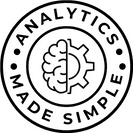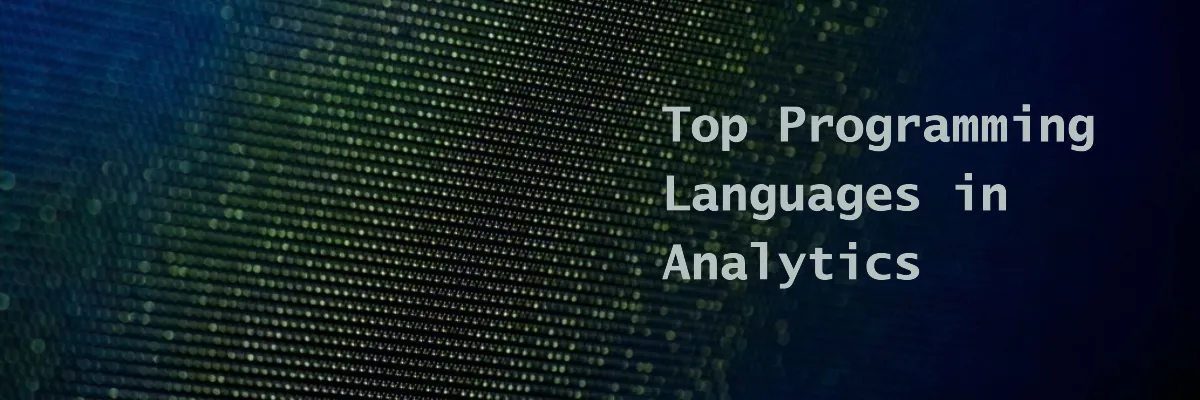New to analytics? You’ll likely hear programmers tossing around all kinds of language names. Python, R, SQL, Julia, Scala – it’s enough to make your head spin!
While you don’t need to become an expert coder, knowing what languages are used and why can be helpful. Let’s decode the top options with some basic background and code snippets.
Table of Contents
Python 
First up is Python, one of the most popular and versatile programming languages out there nowadays. Created back in the 1980s, Python’s straightforward syntax makes it very readable and easy to learn. Python can power all kinds of applications – from web and app development to artificial intelligence.
In the world of analytics, Python is like a trusty Swiss army knife thanks to its wide range of special data science libraries. These readymade toolkits allow Python to handle tasks like manipulating, visualizing, and modeling data with ease. For instance, a digital marketing analyst could use Python libraries to pull in website traffic data, create charts showing trends, and even build a machine learning model predicting future conversions. The simplicity and flexibility of Python make it a great starting language for aspiring analysts.
Use Cases:
- Machine Learning – Building product recommendation systems using classification and clustering algorithms
- Data Visualization – Creating interactive dashboards and plots with Python’s visualization libraries
- Web Scraping – Collecting data from websites using Python modules for scraping
- Automation – Scheduling ETL jobs and workflows with Python automation frameworks
Example:
# Load data science libraries
import pandas as pd
import numpy as np
# Import dataset
data = pd.read_csv("data.csv")
# Calculate summary statistics
data.describe()
R 
Next, we have R, which originated in academia in the 1990s for statistical computing and graphics. While Python is user-friendly, R thrives in advanced statistical analysis and modeling capabilities. Those complex math equations data scientists love? R can compute them with ease.
For analytics, R offers pre-made packages covering specialized techniques like forecasting sales trends over time, visualizing networks, or analyzing genomic data. R excels at turning large, messy datasets into meaningful insights. The learning curve may be steeper than Python, but if you need robust analytics horsepower, R will be your dependable companion.
Use Cases:
- Statistical Modeling – Fitting regression models for predictive analytics using R’s modeling packages
- Forecasting – Time series forecasting of sales trends using R’s forecasting tools
- Bioinformatics – Analyzing genomic data with R’s bioinformatics-oriented packages
- Network Analysis – Visualizing social networks with R’s network graphing libraries
Example:
# Load tidyverse library
library(tidyverse)
# Import CSV file
data <- read_csv("data.csv")
# Generate histogram
ggplot(data) +
geom_histogram(mapping = aes(x = value))
SQL 
SQL, which stands for Structured Query Language, has been around since the 1970s as the standard for interacting with databases. Practically every company relies on databases to store and organize critical information. SQL allows users to efficiently access and analyze that data.
While not flashy, SQL is that reliable old friend you want by your side. Analysts use it to pull customer data for reports. Data engineers employ it to build data pipelines. Data scientists query databases with SQL alongside other languages. Since SQL works across database systems, time invested in learning it pays dividends across roles. When you need to unlock insights from databases, SQL is the key.
Use Cases:
- Business Intelligence – Writing queries to analyze sales metrics for executive reports
- Database Administration – Managing user permissions, optimizing performance
- Data Warehousing – Pulling, transforming, and loading data into a data warehouse
- Mobile Apps – Implementing local database for apps using SQLite
Example:
SELECT category, COUNT(*)
FROM data
WHERE year = 2023
GROUP BY category;
Of all the languages used in data analytics, SQL is arguably the most important one to master. Practically every role relies on SQL skills to some degree, given SQL’s dominance as the standard for database access and manipulation. Data analysts use SQL queries to pull data for reporting and visualizations.
Data engineers use SQL when developing data pipelines and architectures. Even data scientists employ SQL alongside R and Python for collecting, sampling, and cleaning data sets. Furthermore, SQL proficiency is highly transferable, as most organizations leverage some type of SQL or NoSQL database. Whether you’re looking to transition into analytics or boost your current skillset, developing competency in SQL is a worthwhile investment that will provide value across industries and roles.
Julia 
Julia is a newer open-source language designed for scientific and numerical computing. It focuses on high performance and speed, making it well-suited to technical applications in areas like differential equations, bioinformatics, and time series analysis.
For analytics use cases, Julia can rapidly process and model large, complex datasets for tasks like optimization, visualization, and machine learning. While Python and R may be more common for general analytics, Julia’s raw processing power makes it worthwhile for data science applications.
Use Cases:
- Time Series Analysis – Modeling temporal data like financial trends using Julia’s time series packages
- Differential Equations – Solving PDEs for scientific simulations using Julia’s PDE packages
- Optimization – High-performance mathematical optimization with Julia’s optimization tools
- Data Science – Quickly processing and analyzing large datasets with Julia’s data frames and data tools
Example:
# Load dataset
using DataFrames, CSV
df = DataFrame(CSV.File("data.csv"))
# Summarize data
describe(df)
# Visualize data
using Gadfly
plot(df, x=:column1, y=:column2, Geom.histogram)
Julia’s syntax is optimized for speed and takes inspiration from languages like Python and R. The code above loads data, summarizes statistics, and visualizes a histogram.
Scala 
Scala is a programming language that combines object-oriented and functional concepts while running on the Java Virtual Machine environment. It integrates smoothly with Java but with more flexibility.
In analytics, Scala shines when dealing with big data applications thanks to its speed, efficiency and ability to scale. Tools like Apache Spark use Scala under the hood to handle data processing and analytics on huge datasets across clusters of servers. While not as beginner-friendly, Scala becomes indispensable when crunching big data at scale.
Use Cases:
- Distributed Computing – Leveraging Scala’s frameworks for big data processing and analytics at scale
- Stream Processing – Ingesting and operating on real-time data streams with Scala’s streaming libraries
- Data Pipelines – Building reliable and scalable ETL workflows with Scala data pipeline tools
- Web Development – Developing high-traffic web apps and services with Scala web frameworks
Example:
// Import libraries
import org.apache.spark.sql.SparkSession
// Initialize Spark session
val spark = SparkSession.builder().getOrCreate()
// Load CSV file
val df = spark.read.option("header", "true").csv("data.csv")
// Perform analysis
df.describe()
Scala combines object-oriented and functional programming. Here Spark handles loading and analyzing a dataset.
Summary
And there you have it folks! In summary, this overview provided a high-level introduction to key programming languages used in data analytics like Python, R, SQL, Scala, and Julia. Each language has its own strengths and best use cases.
For those new to analytics, the variety of options may seem daunting initially. However, it is important to remain focused on acquiring foundational skills in a select few languages rather than pursuing a superficial understanding of many languages.
Aim to gain working proficiency in 1-2 languages to start. Python and SQL are reliable choices given their versatility. Find an approachable learning resource, start applying your skills on real projects, and don’t be afraid to lean on the community for guidance when you need it. We data folks love to help! The key is picturing the types of problems you want to solve, then letting the programming follow naturally.
Cheers!
-J








